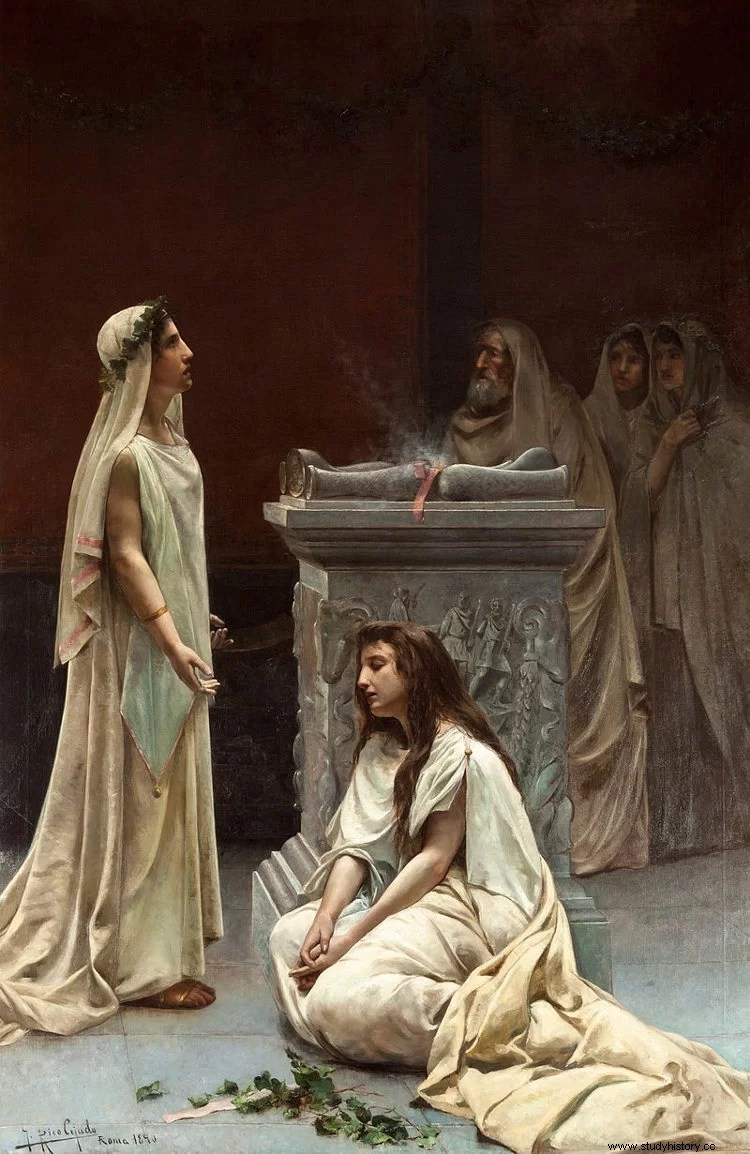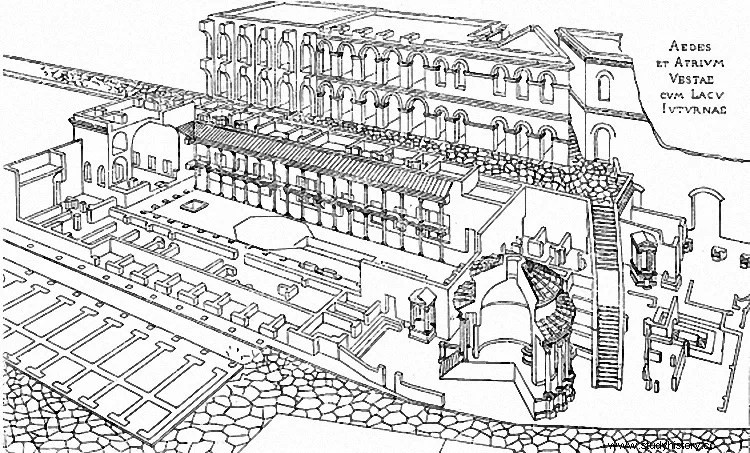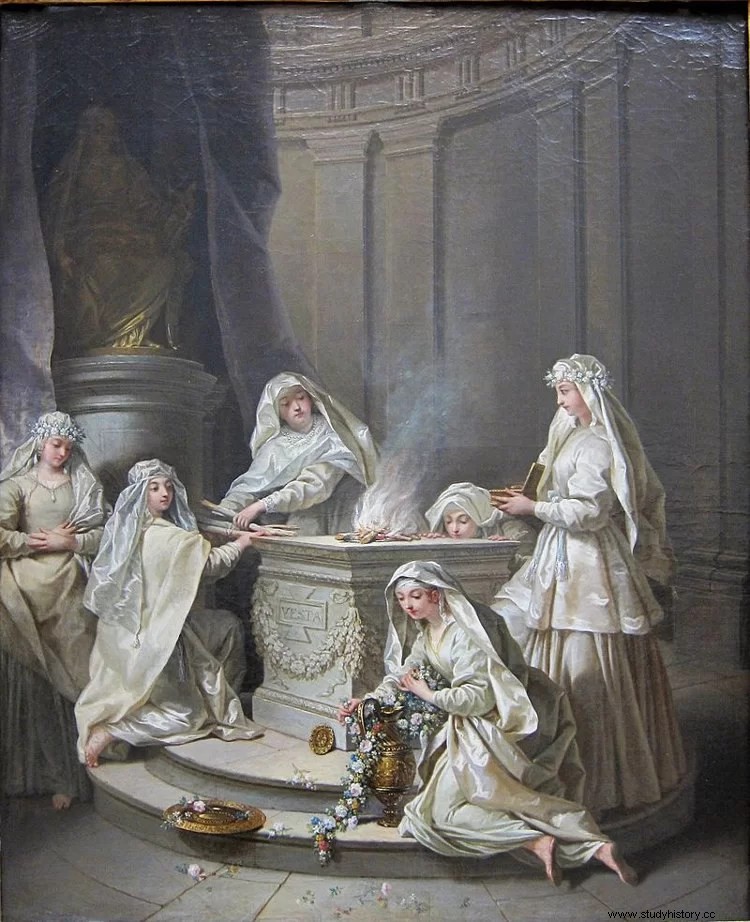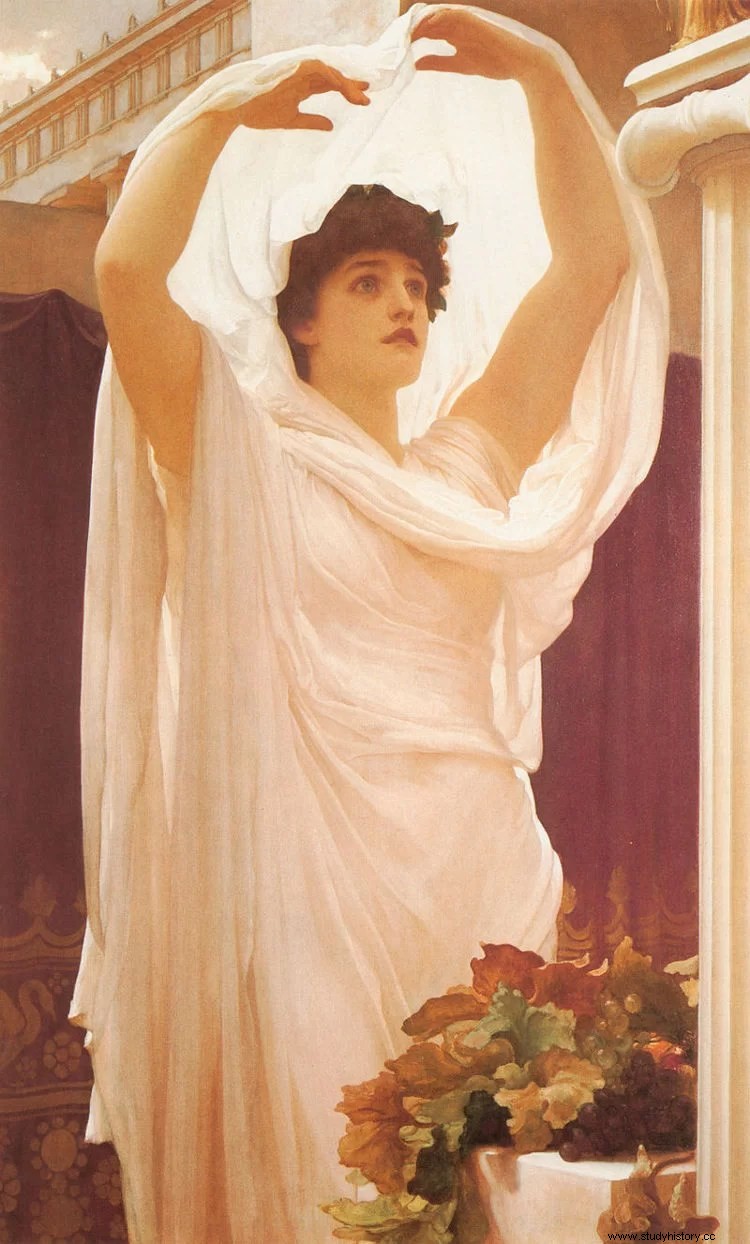One of the most iconic corners of the Roman Forum is a fragment of the wall of a cella surrounded by five Corinthian columns that, supported on a podium, support the remains of a linteled entablature with frieze and architrave.
It is what remains of the ancient temple of Vesta, which guarded the sacred fire and was closed in 391 by Emperor Theodosius I when he definitively banned the ancient religion. Also at that time, the functions carried out by Celia Concordia, the last vestal, definitively ended.
The temple of Vesta is under the Palatine hill, at the eastern end of the Forum, before the Regia (residence of the maximum pontiff) and near that of Castor and Pollux; in short, the heart of what was once the neighborhood of the vestals. Vesta, daughter of Saturn and Ops (Sabin goddess of fertility and earth, equivalent to the Greek Rhea), sister therefore of Jupiter, Neptune, Pluto, Juno and Ceres, was the goddess of home and fidelity, an assimilation of the Hestia helena but with greater importance.

Tradition says that her cult was established by King Numa Pompilius in gratitude for her intercession so that her grandfather Numitor did not kill her daughter Rea Silvia, who had become pregnant with the twins who would later become Romulus and Remus.; the first would be precisely the father of Numa, so the initiative of his offspring is explained. As the cult required a clergy, an exclusively female priestly class was instituted - something unusual in Rome - whose main mission was to keep the sacred fire burning.
That flame was the only representation of the goddess, as it lacked specific human iconography, so it should never go out, as this would mean a harbinger of disaster for the city. Hence the legend of the vestal Emilia, who, falling asleep and extinguishing the fire, implored Vesta to revive him and she agreed:one end of Emilia's tunic had remained on the embers, still burning, so it could be reactivated. Otherwise, they would have flogged her and had to set the fire again, with the permission of the Senate, using a mirror to reflect the sun's rays.

Now, keeping the fire was its most important function but not the only one; there were others, like preparing the mola sauce , a porridge of unleavened and salty bread that people ceremonially offered to the gods in the lararium (domestic altar) during the celebration of parties such as the Vestal, the Matralia, the Fornacalia and the Lupercalia, in addition to all those that were made in honor of Jupiter. They also took care of the Palladium, a statue of Athena (Minerva) that according to tradition had been brought to Rome by Aeneas when he escaped from Troy. They also guarded the wills of illustrious Romans, in the case of Julius Caesar.
The vestals were two at first but their number increased, first to four and then to six. They had to have patrician parents, be beautiful and virgins, swearing to maintain their chastity on pain of death. They wore a palla (shawl) over the tunic and were worn with a characteristic and exclusive vitta (ribbon that tied her six regulatory braids), a sufibulum (white wool veil) and an infula (red hanging ribbons).
When they were between six and ten years old, the pontifex maximus , principal of his collegium , he selected them for a task to which they would dedicate thirty years of their lives (ten of learning, ten of service and ten of teaching their successors); the initiation rite consisted of cutting their hair and suspending them from a tree to symbolize their independence. They lived in community, in a building located behind the temple that was ceded to them in the second century BC. and was known as Atrium Vestae . The question that many will ask is:was it worth so much sacrifice?
In a way, yes, and it shows that many chose to stay within the collegium at the end of your service. After all, apart from guaranteeing the continuity of Rome, the vestals enjoyed prerogatives superior to those of most Roman women:they had full power over their property and people, without the need to submit to the authority of a curator (guardian), they could make a will, they were authorized to decide the freedom of an inmate during his way to the gallows if the encounter was casual (also of a defeated gladiator) and any attack against them, whether in action or word, was punished with capital punishment.

Commanding the vestals was a Virgo Vestalis Maxima o Summa Vestal who represented them in the collegium pontificum , a college of pontiffs (the highest priestly hierarchy), further composed of the Pontifex Maximu yes, the Rex Sacrorum (high priest of the patricians) and the flamines (the most prestigious priests). It should be noted that there were three other colleges, that of augurs (fortune tellers), that of quindecimviri sacris faciundis (the fifteen custodians of the Sibylline Books and foreign gods) and that of epulones or septenviros (the seven who had to organize parties and games).

The Vestalis Maxima stood out over the other two Roman high priestesses, the Flaminica Dialis and the Regina Sacrorum , in which they carried out her work together with her male counterparts, while she had absolute responsibility. And the last to hold this prestigious position was Máxima Celia Concordia, who acceded to it in the year 384 AD. If ever he imagined that he would go down in history, it would not be for that reason or for what others did, some executed for violating their celibacy (twenty-two in their entire history), others for their heroic sacrifice in the face of danger (Tarpeya) and some for their more or less direct intervention in politics (Claudia).
No, if Celia Concordia aspired to immortalize her name, it would rather be, perhaps, for trying to overcome the fifty-seven years that her predecessor, Occia, held her position, who assumed it in 38 BC. and she kept it until her passing in AD 19. Since then no one has been able to approach that record. But she had to go through something much more bitter for her and for all the devotees:the end of the polytheistic Roman religion and its replacement by another monotheistic one that had long since spread to the point of practically displacing the first:Christianity.
Born three centuries earlier, it had grown to constitute a structured faith that spread among the Romans, despite the persecution unleashed against it by some emperors. Circa 300 AD It was already rooted, both among the popular classes and the wealthy, so that some authors believe that it could reach up to a quarter of the total population of the empire. An unavoidable reality that led to Constantine the Great to allow the cult of him along with the other religions in 313 AD. and even to be baptized shortly before dying, twenty-four years later.

The definitive step was taken by Theodosius in 380 AD. with the Edict of Thessaloniki, by which Christianity became the official religion of the Roman Empire. Other beliefs were still allowed and this included the traditional Roman, only pushed to a secondary place because it no longer represented the state in its ceremonies and received no funding. In the absence of solving the problem of the various doctrinal currents, Theodosius's move was cunning because he constituted himself as the highest authority of Christians, priests included. However, this brought him up against the hierarchy and in 390 he was even excommunicated by Bishop Ambrose, because he had ordered the death of thousands of people in Thessalonica in retaliation for the death of the city's military governor. 
In order to ingratiate himself he had to show repentance and change his policy of tolerance towards the pagans for another of the opposite sign. Thus, he prohibited blood sacrifices, suppressed economic allocations to cults and decreed the closure of temples and sanctuaries, many of which were demolished to erect Christian churches on the ruins; In this context, the destruction of the Serapeum of Alexandria took place and with it, probably, the famous library. Anyone who practiced another religion would be prosecuted and the Olympics were abolished.
As you can imagine, in such a situation Vesta was outlawed and with her her vestals. Celia Concordia's Swan Song as Vestalis Maxima it took place in 391, when Theodosius closed the temple of Vesta; she and her priestesses had to leave the house they occupied, built by Septimius Severus in 191 AD. having burned the previous one in a fire, to reconvert it into the residence of officials (and later, court of the Pope). Celia Concordia held the position for three years but, obviously, she was doomed to disappear and political events precipitated it.

In 392 AD, the Western Emperor Valentinian II took his own life or was assassinated by his magister militum , the Frankish general Arbogastes. Theodosius accused him of the crime and when he saw that he raised to the throne a pagan, Eugene, he declared war on him.
This was settled in the battle of the Frigid, where Theodosius was victorious, managing to reunify the empire for the last time. It was the year 394 AD. and Celia Concordia understood that her time was over, giving up being Vestalis Maxima .
What happened to her next? Tradition says that she lived twelve more years and shortly before she died, she ended up converting to Christianity, perhaps sincerely, perhaps forced. In 384 AD, on the death of Vetio Agorio Pretextato, a Roman patrician who distinguished himself in opposition to Christianity, she had erected a statue in his honor and his widow reciprocated that attention by placing another of Celia in her garden.
This sculpture was found during the Renaissance but was later lost again; a pity because it was the posthumous testimony of the last vestal.
